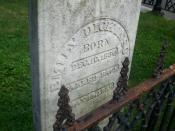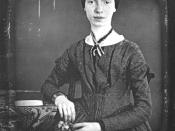Emily Dickinson was an American lyrical poet, and an obsessively private writer. Dickinson was born in Amherst, Massachusetts, to a family well known for educational and political activity. Her father, an orthodox Calvinist, was a lawyer and treasurer of Amherst College, and also served in Congress. She was educated at Amherst Academy (1834-47) and Mount Holyoke Female Seminary (1847-48). Around 1850 Dickinson started to write poems. They were first in fairly conventional style. After ten years of practice she began to give room for experiments. She assembled many of her poems in packets of fascicles, which she bound herself with needle and thread.
After the Civil War Dickinson restricted her contacts outside Amherst to the exchange of letters. She dressed only in white and saw few of the visitors who came to meet her. In fact, most of her time she spent in her room. Although she lived a secluded life, her letters reveal knowledge of the writings of John Keats, John Ruskin, and Sir Thomas Browne.
Dickinson's emotional life remains mysterious, despite much speculation about a possible disappointed love affair. Two candidates have been presented: Reverend Charles Wadsworth, with whom she corresponded, and Samuel Bowles, editor of the Springfield Republican, to whom she addressed many poems.
After Dickinson's death in 1886, her sister Lavinia brought out her poems. She co-edited three volumes from 1891 to 1896. Despite its editorial imperfections, the first volume became popular. In the early decades of the twentieth century, Martha Dickinson Bianchi, the poet's niece, transcribed and published more poems, and in 1945 Bolts Of Melody essentially completed the task of bringing Dickinson's poems to the public. The publication of Thomas H. Johnson's 1955 edition of Emily Dickinson's poems finally gave readers a complete and accurate text.
Dickinson's works have had considerable influence on...


